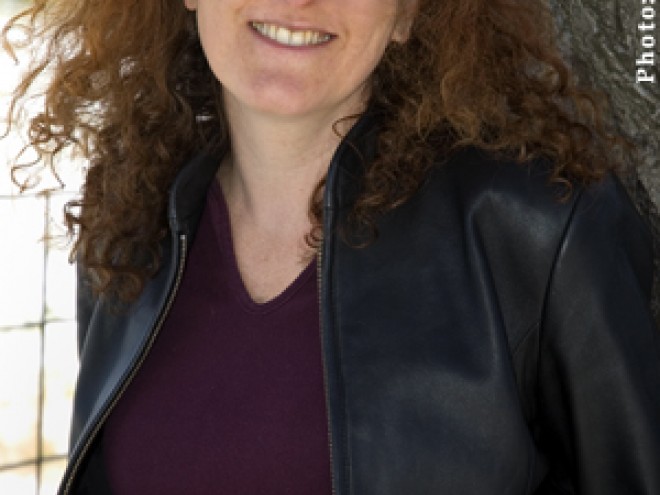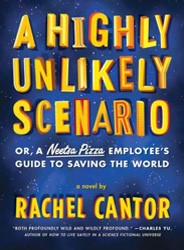Rachel Cantor is the author of the novel A Highly Unlikely Scenario, or a Neetsa Pizza Employee’s Guide to Saving the World (Melville House). In addition to writing fiction, she freelances as a writer for nonprofits that work in developing countries. She will be blogging here all week for Jewish Book Council and MyJewishLearning.
I don’t speak Hebrew and, despite a few semi-earnest attempts to learn my aleph-bet, I don’t read it either. I recognize enough spoken words of biblical Hebrew that I can more or less follow an English translation when someone reads Torah, but that’s about it. And while I’ve studied some Kabbalah, I am no scholar: I know that individual Hebrew letters are associated with specific mystical qualities, but I cannot tell you what they are. Still, I am fascinated by the aleph.
Toward the end my novel, A Highly Unlikely Scenario, or a Neetsa Pizza Employee’s Guide to Saving the World, the thirteenth-century Jewish mystic Abraham Abulafia appears before my hero, the hapless Leonard, in the old medieval basilica of St. Peter’s in Rome. Known for his meditative work combining Hebrew letters, Abulafia hovers over Leonard (literally: his feet do not touch the ground), juggling Hebrew letters in fantastic, unfollowable patterns. He wants to impress Leonard with his message, and he does. But unbeknownst to him, he drops an aleph as he dematerializes. The remainder of the book hinges on this aleph. Leonard can exchange it for something he badly needs (his seven-year-old nephew Felix!). It also, not incidentally, allows him to save the world. Phew!
The aleph! I know of it what you probably know: first letter, no sound, the beginning of the words echad, referring to divine unity; ein sof, the infinite which is the divine source of all manifestation; and emet, or truth. Powerful! But if I must be truthful, it was not my rabbi teachers who drew me to the letter, it was the Argentinean writer Jorge Luis Borges.
Borges may or may not have been descended from Portuguese Jews, but his interest in Jewish texts, symbols, and ideas defined a sizeable portion of his life and work: he translated Kafka, loved Buber’s Hassidic tales, and lectured on the Kabbalah; he wrote stories with Kabbalistic and other Jewish themes, and searched his ancestry (in vain, apparently) for Jewish forebears. Whatever his “pedigree,” I love his work and, in particular, his 1945 story “The Aleph.”
In this story, a horrendously pedantic poet by the name of Carlos Argentino Daneri is writing an epic poem that seeks, basically, to describe everything on the planet, or maybe even the universe. He is aided, it turns out, by an aleph in his basement, which, he explains to the story’s narrator, is a point in space that contains all other points. Looking into it, one can see everything that is — clearly and at the same moment. The narrator is allowed a glimpse; he describes the resulting vision necessarily as a succession of images, though of course he sees them all simultaneously. What follows is a beautiful paragraph listing some of these images, both enormous and minutely specific (deserts and each of their grains of sand, his own bowels, horses on the shore of the Caspian Sea, the obscene letters his beloved had written to this pedantic poet …).
 One of my favorite writing exercises when I taught for one brief year was to assign students this story and ask them to write such a list of images — just the list: they didn’t have to create a story about or around it. I guessed that freed from the rigors and constraints of narrative they too would write astonishing paragraphs — and they did! I startled them by asking to keep those lists (at a time when teachers still received hard copies of student work!) — they were that good. I have them still.
One of my favorite writing exercises when I taught for one brief year was to assign students this story and ask them to write such a list of images — just the list: they didn’t have to create a story about or around it. I guessed that freed from the rigors and constraints of narrative they too would write astonishing paragraphs — and they did! I startled them by asking to keep those lists (at a time when teachers still received hard copies of student work!) — they were that good. I have them still.
In my book, the aleph (which, naturally, quivers and vibrates) is more focused: it does not allow viewers to see the entire universe from every conceivable angle; rather, it enables them to see scenes from their own lives, past and future; this, in turn, helps them understand and embrace their destinies. The vision is no less transformative, however. A variation of Reb Borges’ aleph, to be sure, but a heartfelt homage nonetheless!
Rachel Cantor’s stories have appeared in magazines such as the Paris Review, One Story, Ninth Letter, Kenyon Review, and the New England Review. Rachel lives in New York, in the writerly borough of Brooklyn. She is, always, at work on another book. Read more about her here.



